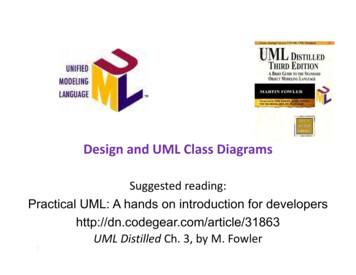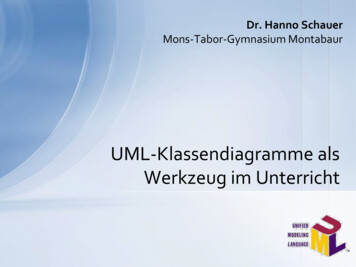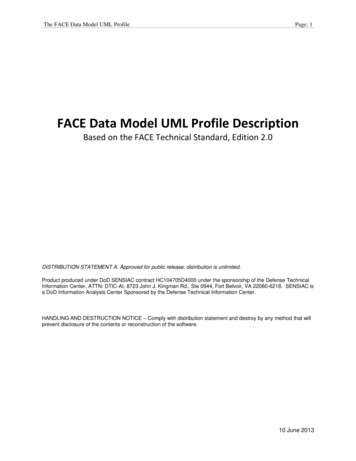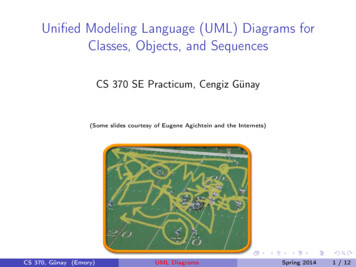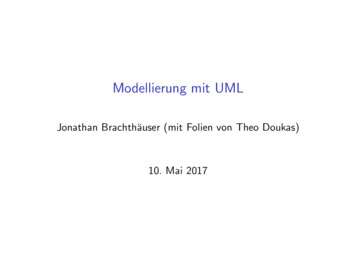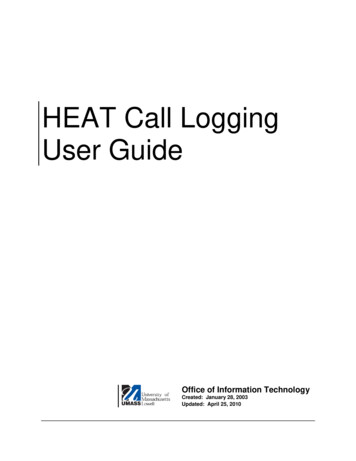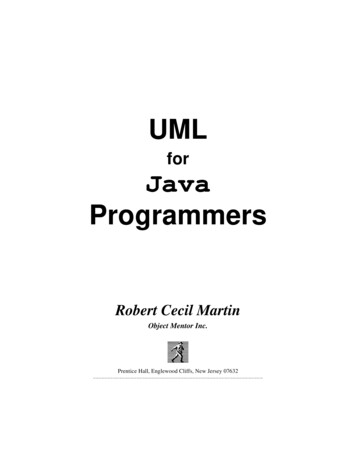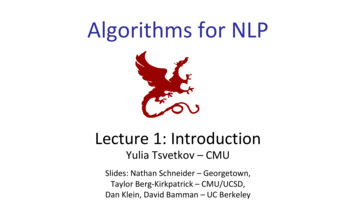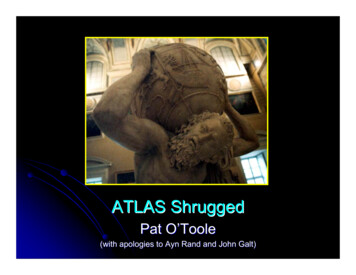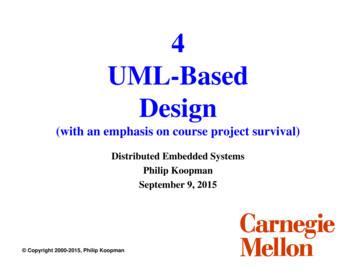
Transcription
4UML-BasedDesign(with an emphasis on course project survival)Distributed Embedded SystemsPhilip KoopmanSeptember 9, 2015 Copyright 2000-2015, Philip Koopman
sparency/UCM388442.pdf2
Where Are We Now? Where we’ve been: Embedded system intro & foundations Elevator domain knowledge Requirements Did you notice the “lessons learned” from last semester in the handouts lastlecture?(also available on-line) Where we’re going today: UML overview & design process for course project Where we’re going next: Pepsi vending machine exampleDistributed Embedded system conceptsCase studies (Boeing 777, Toyota Electronic Throttle Control System)Reviews & Inspections3
Preview Design process A set of steps to get you from requirements to design Specifically, the design process we’ll be using for the course project Intro to Unified Modeling Language A standard representation for designs and implementations It’s not perfect, but it gets a lot of the job done– Note: we’re not grading on nitty gritty language lawyer stuff, but this helps give auniform representation for class work A complete end-to-end example in the next lecture!– This lecture has some informalities to simplify things; next lecture looks & feelslike project notation Important: this course is about teaching survival skills, not being an allencompassing tutorial on UML (or many other subjects) Note: you are going to see some things multiple times. These are the thingssome students struggled with in previous years – we are only repetitive wherewe have good reason to be!4
General Process Flow We’re going to assume aniterated Vee processREQUIREMENTSSPECIFICATION Top-down refinement Front-to-back flow Repeat cycle with more complexrequirements after mid-semester point VALIDATION & TRACEABILITYACCEPTANCETESTReviewReviewVERIFICATION &TRACEABILITYSYSTEMSPECIFICATIONSYSTEMINTEGRATION& TESTReviewReviewVERIFICATION &TRACEABILITYSUBSYSTEM/COMPONENTSPECIFICATIONReal projects vary But the same representations are usefulregardless of the sequencing Usually architecture & ReviewVERIFICATION MODULESPECIFICATIONReviewVERIFICATION &TRACEABILITYUNIT TESTReviewReviewSOURCECODEReview– (Lecture flows better with architecture first,so that is today’s discussion) This lecture concentrates on the pieces What the pieces really are How they fit together Next lecture is end-to-end example5
Why UML (Or Any Other Notation?) UML “Unified Modeling Language” It isn’t actually Unified; it’s all the best known ideas tossed into the same sack And, it’s more a set of graphical techniques than a textual language UML isn’t novel; it’s just a common representation Gives a way to exchange ideas via standardized set of diagrams Gives a standard way to document thoughts for later access UML is NOT a design methodology there are many ways to use UML in a methodology and we’re just nowfiguring out the better ways to do this. There is not (yet) any “best” process “Best” varies depending on size of team, complexity/novelty, and companyculture But, it’s better to have some process than no process And, the ability to follow an arbitrary, but specified, process is important6
UML-Based Process-“Lite” For Our Course System-level requirements Use cases High level text requirements Architecture – emphasis on “nouns” Class Diagrams & object descriptions – sensors, actuators, controllers Interfaces – network message dictionary Software Requirements – emphasis on “verbs” Text-Based Scenarios – different scenarios for each use case Sequence Diagrams – graphical scenarios with emphasis on interaction “messages” Design Textual software requirements specification – per-module behaviorsState Charts – state transitionsTest DesignFailure analysis (covered later in semester)Verification & Validation TraceabilityUnit testingIntegration testingAcceptance testing7
Why Not Just Write The Code? That can work for up to perhaps 100 lines of code Most embedded systems are a lot biggerMost embedded systems have to be nearly perfect and on timeProblems tend to become exponentially worse with complexity/program sizeChapter 2 in text talks about thisThe stakes are too high to get it wrong! But, there are countless projects that do get it wrong– With resultant loss of money, jobs, lives, . Example:In July 1999, General Motors had to recall 3.5 million vehicles because ofan anti-lock braking software defect. Stopping distances were extended by15- 20 meters. Federal investigators received reports of 2,111 crashes and293 injuries. http://autopedia.com/html/Recall GM072199.html Other care companies have recalls too – GM is just an example– Since then, GM has been working on software quality (and so have the others)8
Project Template We provide you with a structured template for project information Soda vending machine template is an example of how to do things Elevator template is the starting point you should build on for the project9
“Marketing/Business” Context Goal: “Build an elevator using distributed embedded system approach” Note: there is a lot of historical precedent for what it means to be “an elevator” High level spec. is: “make it act like the HH primary elevator except better” In our role as the “customer,” we require you to use: Our set of predefined components (buttons, lights, etc.)Our embedded network message types (you can add some later)Our simulation framework in Java as the implementation platformOur design processGeneral guidance: If in doubt, make it act like the Hamerschlag Hall main elevator– But as long as satisfies project requirements, OK to deviate from this You can add extra features later in project– You can add network messages with our permission only– In general, you can NOT add extra system objects until after mid-term because everyone in the past got themselves into trouble doing it!10
Top-Level Product Requirements Elevator Top-Level Requirements1.2.3.4.All passengers shall eventually be delivered to their intended destination floor.Any unsafe condition shall cause an emergency stop.An emergency stop should never occur.Performance shall be optimized to the extent possible, where performance isdefined by the formula:–( 4 * average passenger delivery time) maximum passenger delivery timePerformance is improved by reducing that value (short delivery times are better).– Delivery time is counted from the time a passenger arrives at a floor to begin a tripand ends when that passenger exits the elevator car. (Note: this is an arbitraryformula for this project, but the general idea holds true for real elevators.)11
What’s an Architecture? Architecture definitions: System: The structure – in terms of components, connections, and constraints –of a product, process, or element. [Rechtin96] For our purposes, an architecture is: A set of objects– Sensors– Actuators– Controllers The interfaces between those objects– Network messages– Analog interface pseudo-messages12
Hardware Architecture Pattern For This Project Highly Distributed Networked System Abstraction principle: One sensor, actuator, or servo pair per CPU, on anetwork Bus interconnect– Bus hierarchy may be needed to overcome bandwidth limits Pro: doesn’t prevent mapping to other architectures– Can simply co-locate code for multiple CPUs on a single hardware CPU Pro: teaches you how to think “distributed” as you do the project Con: bus can be a bottleneckCPUCPUCPUCPUCPUCPUAS ASS ASS A13
Software Architecture Pattern For This Project Object oriented / Federated Abstraction principle: partition by data types, hide data behind methods– Note: flow of control is completely obscured Pro: helps with multi-vendor/mult-subsystem integration(compatible with CORBA) Con: can have high overhead to access dataOBJECT "BUS"METHODSMETHODSMETHODSDATADATADATA14
Communication Architecture Pattern For This Project Global priority Abstraction principle: highest priority message delivered first– Does NOT require a physical node to act as a queue – fully distributedimplementations are commonly used!– Represents CAN protocol Pro: priority helps meet deadlines Con: priority interferes with fairnessNODENODENODEPRIORITYQUEUENODE15
Control Architecture Pattern For This Project Federated Agents/“Blackboard” Abstraction principle: each object has a control agent; agents monitor andtransmit global state information for coordination “Blackboard” has shared state variables"BLACKBOARD"SHARED GLOBALSTATE INFORMATIONAAGENTAS AAGENTSS A SAAGENTASS A16
Software Architecture: UML Class Diagrams Used to show system in terms of objects, attributes, and relationships Objects are “nouns” in the system Attributes are local state data within an object This is “sort of” an architectural diagram[Rational]– For our purposes, composition & aggregation are the same thing» (Difference has to do with class/instance dependencies that don’t affect us)17
Example Elevator Class Diagram18
Our “Architecture Diagram”19
Message Dictionary (part of architecture)mAtFloor[f, b](v): Floor proximity sensor. v {True, False}. True if the elevator is at the floor f and there is a door on hall h (front orback of elevator, or both), false otherwise.mDrive(s,d): 3-speed main elevator drive. s is speed s {Fast,Slow, Level, Stop}, d is direction d {Up, Down, Stop} The commanded speed and direction of the car; 2 fields Speed - one of {STOP, SLOW, FAST} Direction - one of {STOP, UP, DOWN} Forour type of system, it is a list of system-level statevariables that describe state of objects For example, each AtFloor sensor periodically broadcasts its ownmAtFloor20
Detailed Object Descriptions (part of architecture) DoorOpened[b, r]: Door Opened switches One per Door [b, r] for b {Front, Back}and r {Left, Right}.(total four sensors for two pairs of doors) Indicates True when the Door[b, r] is fully open. Set to False at initialization. mDoorOpened[b, r] shall be True if and only if mDoorPosition[b, r] has a valuegreater than 490. Interpretation notes: [b,r] means there are four doors: LeftFront; LeftRear; RightFront; RightRear (v) means that the object broadcasts the value (v) which in this case is:– True means door is fully open– False means door is not fully open (might be partway open – does not implyclosed) We have intentionally designed the elevator so messages broadcast theinternal state of each architectural object There are other ways to do things in other approaches.21
System-Level Requirements: Use Cases Useful for identifying different things system must do Actor initiates a Use Case Represents the system from the actor’s point of view System can act on environment OROPENDOORSDOOR CONTROLLERCLOSEDOORS Problems: Who are the actors? (In general must include machines as well as people) Usually end up assuming a single centralized system control actor22
An Example23
How Big Should A Use Case Be? There is some art to sizing the use cases End-to-end ride on elevator is too big One line of code is too small In general, use cases are intended to capture a “transaction” E.g., request a bank balance on an automated teller machine Usually, a user session has multiple transactions (request balance; withdrawmoney; ) In elevator case, it should be a situation that is a nice building block For example, approach elevator and tell it you want to go up/down– Or, “make a hall call” for short Names should be 2-5 words long and relatively descriptive, with emphasis onVERBS / actions– These are about how users want to use the system, not how the system is built Let’s talk about scenarios so you can see how size affects the next step24
Scenarios – what happens inside the use case Nominal – ways in which user and system interact Often multiple alternate scenarios for each use caseEach scenario is the same “size” as a particular use case from end to end Off-nominal – exceptional and failure situations Informal Example (a scenario for Enter Elevator use case): 1.2.3.4.5. Initial condition: user is waiting for elevator to arrive in desired directionThe car reaches the floor, stops, and opens its doorThe car illuminates appropriate direction lanternUser entersThe car clears the hall call that was just servicedThe car closes doors and extinguishes direction lanternNote that multiple scenarios are invoked for end-to-end service Commonly scenarios are independent in “toy” problems and bank ATMsBut, NOTE: standard UML does not have any notion of Use Case order25
A More Complete Example Scenario Summary Description: Pre-conditions: Open doors from within carPassenger is in the car.Elevator has arrived at the desired floor, but the passenger has not yet exited the car.Doors are fully open.The car call button for the current floor is not lit.Scenario actions:1. Doors begin to close, which will prevent passenger from exiting the car.2. Passenger’s brain turns back on and (s)he presses car call button for current floorbefore doors are fully closed.3. Doors stop closing and reopens fully. Post-conditions: Passenger is still in the car.The doors are fully open.The car call button for the current floor is not lit.26
How Big Is A Use Case? – Revisited Using an elevator is a series of use cases Example: hall call, elevator moves to start floor, doors open, enter elevator, carcall, doors close, elevator moves to destination floor, doors open, exit elevator,doors close Each use case has multiple scenarios – almost always more than 1! Scenarios within use case must have compatible pre- & post-conditions Post-conditions of one scenario need to match pre-conditions of next scenario Thus, use cases
True if the elevator is at the floor f and there is a door on hall h (front or back of elevator, or both), false otherwise. mDrive(s,d): 3-speed main elevator drive. s is speed s {Fast, Slow, Level, Stop}, d is direction d {Up, Down, Stop} The commanded speed and direction of the car; 2 fields Speed - one of {STOP, SLOW, FAST}
